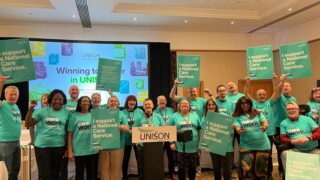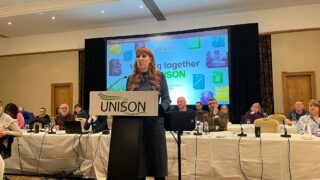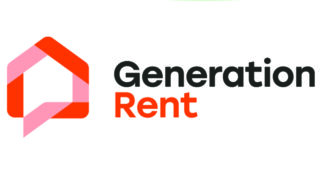Bradley Arnold works for Livv Housing Group, one of the largest housing associations (HAs) on Merseyside. What’s a housing association, you ask? As Bradley explains: “They’re meant to be a non-profit organisation, which provide social, affordable rental homes to people. What everybody historically knows as council housing.”
Until three or four years ago, Livv was known as Knowsley Housing Trust, which in 2002 received the transfer of homes from the local authority.
The waiting list

Bradley (pictured left) works in the association’s choice-based letting/property pool team – in effect, the team that organises the social housing waiting list. People who want social housing will apply to the list, fill in a form, and are assessed and prioritised by the team.
“We allocate people a band based on their housing need. If you’re homeless, you will get priority”.
This is decided by several factors including “health and welfare, overcrowding, issues accessing their current property, homelessness, whether they are a recent armed forces leaver, or a recent care leaver, and more.”
After that, each week people can place bids on properties available in the area and go on a shortlist. Properties are then allocated by the priority which Bradley’s team give them.
Over the seven years he has worked there, Bradley has “seen the wait times go through the roof. People aren’t getting housed – the average wait time is about 18 months for someone to get a property. Unless you’ve got a band A, the likelihood of you getting something is very slim.”
All the while, “you’ve got this growing waiting list with no relief, which means private landlords can charge what they want. It’s a vicious circle”.
Why is ‘social’ housing in a mess?
For Bradley, the main answer to that question is a lack of housing stock. “When right to buy came in, thousands of people bought their properties, and nothing has ever been done to replace them.”
Now, even with housing propelling itself into headlines as a national issue, not enough houses are being built. And, as Bradley points out, “Where I work, they are building hundreds of properties, but only a handful are going into the social housing waiting list. It’s all shared ownership.”
So, build more proper social housing. Easy. But, aside from the obvious cost of building the houses, Bradley notes that development costs – what it costs the council to build the infrastructure around new housing – are currently soaring.
“You can build a four or five hundred property estate, but you’ve got no new school, no new doctors. You’ve got private developers who are supposed to provide what’s called ‘Section 106’ money [to support development costs], but it’s minimal.
“When our area does eventually build social housing to go on the waiting list, the rent costs are massive because they have to offset these development costs. So, it’s easy to say ‘build more properties to ease the stress’, but it’s not that simple.”
In the meantime, more and more pressure is piled on his team as they deal with an ever-growing waiting list. “Overall, we’ve lost one member of staff from the team but the workload has doubled. We get abuse 24/7 because people are waiting years for properties.”
His team isn’t the only one in housing coming under increased pressure, he says. “This isn’t just a housing crisis, but a mental health crisis as well.
“Our housing officers are dealing with situations they shouldn’t be dealing with. We used to have an anti-social behaviour team, a rents team and a lettings team, now it’s just a housing officer team. They have a patch and deal with everything that crops up on it.
“When you hear some of the stories they tell, its mad. They’ve had so many managers over three years.”
Insourcing
Recently, the contract for Bradley’s team came up for tender. “Livv basically turned round and said: ‘We’re not making any money from it, and are getting a lot of complaints’, so they didn’t re-tender it, and the council didn’t get any other offers, so were forced to take it back in”.
As a result, the team will be TUPE transferred back in-house to Knowsley Council. Bradley views this as a good thing, and there will be benefits for the team – particularly in terms and conditions: for example, employer pension contributions will go up from 6% to between 13%-16%.
Furthermore, he says: “The homelessness team were brought back in recently, and when the authority saw that due to increased homelessness the team was over worked, they nearly doubled the team in size.”
But it will also help in something Bradley views as vital for the wider sector – union organising. “Because it’s difficult to build the union membership density in HAs, it’s hard to change anything. We had a recognition agreement, but a lot of people in HAs don’t.”
People working for HAs also struggle to engage within UNISON’s structures, as they are often members of local government or health branches, rather than dedicated community branches.
“It’s an untapped set of members,” says Bradley. “It would be a big piece of work to do [to create that engagement within the union’s structures], but I think it would pay off”.
Find out more at unison.org.uk/community






